

The Emerson 561 is an AM broadcast band table radio designed by Raymond Loewy and produced in in the late 1940's. Unlike most radios of the era, the chassis slides out from the bottom of the radio. This has to be one of the dirtiest chassis I've worked on. Beneath the heavy layer of dust, I found very little rust, but the usual layer of greasy grime. The chassis bottom plate had a fair amount of rust, though. It all cleaned up well with white vinegar and alcohol.

It had a full complement of Emerson branded tubes, three of which were bad. The oscillator and IF amp are 6SS7 tubes, which I didn't have, so I had to order those. The 12AT6 detector-AVC-AF amp tube was also borderline, so I replaced it with an Emerson 12AT6 I had on hand.
I did the usual recap of the electrolytics and wax/paper caps, along with a half-dozen or so resistors. When the tubes arrived, I did my first smoke test, and got good reception and good audio. It's not the most sensitive receiver, but it picks up all the local stations well. I installed a new 47 dial light bulb and straightened and repainted the dial indicator. Once the chassis was correctly re-installed in the cabinet, I installed the two knobs with new felt washers, and made sure it was playing OK.
Raymond Loewy probably designed many of the manufactured products from the 20th century, from the Lucky Strike package, the Coke bottle, several models of automobiles, including the Studebaker Avanti, and the livery for Air Force One. His radio designs, in addition to the Emerson 561, include a couple Hallicrafters models, most notably the S-42.
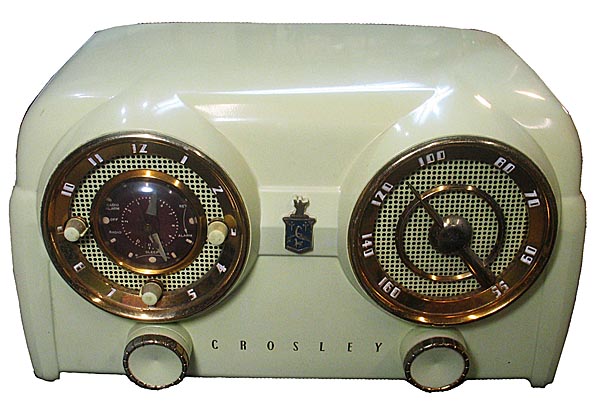
1952 Crosley D25CE Clock Radio
Crosley "Dashboard" radios are iconic symbols of mid-Twentieth Century industrial styling. Intended to resemble the dashboards of early 1950's automobiles, Crosley produced several styles of their "Dashboard" radios. The model D-25 and its variants are perhaps the most attractive, and the only version that included a clock. This radio is quite pristine, with no cracks or chips, and just a bit of wear on the brass clock surround from use.
This is a D-25CE, the model designation for the chartreuse cabinet. Other colors were produced as well. The radio itself is a basic five tube All-American design with a loop antenna embedded on the rear cover. This particular radio is quite sensistive despite not having an RF amp. The audio qualilty is quite good. The radio was dead when I acquired it, but that was due to a bad output tube. I completely recapped the radio and replaced quite a few capacitors.
The Telechron clock runs accurately and silently. I gave it a drop or two of clock oil. The clock knob at the 9 o'clock positive turns the radio on or off, or selects Radio Alarm mode, which allows setting the radio to turn on at a particular time. There's also a standard wake up alarm, and a sleep timer that lets the radio play for 60 minutes and then shut off. On the left side, there's a 120VAC outlet that can also be set to turn on an appliance, such as a coffee pot, at a predetermined time.
Finally, the radio features an RCA phono jack and switch on the rear panel. Most any audio device, such as an old RCA 45 record player attachment, CD player, or a smartphone, can be connected to the input with an appropriate adapter cabe and played through the radio.
Crosley went out of business in 1956. In the early 1990's, Modern Marketing Concepts in Louisville, KY, acquired rights to the Crosley brand. The revived Crosley Company began offering reproductions of various Crosley radios, along with several models of record players. Around 2000, a reproduction of the Crosely D-25 radio was produced. It included an FM band and built in cassette player. I don't know how good the reproduction Crosley radios are, but their record players have a poor reputation for quality and reliability; some may even damage vinyl records, according to consumer reviews.
Click Here to watch a You Tube video
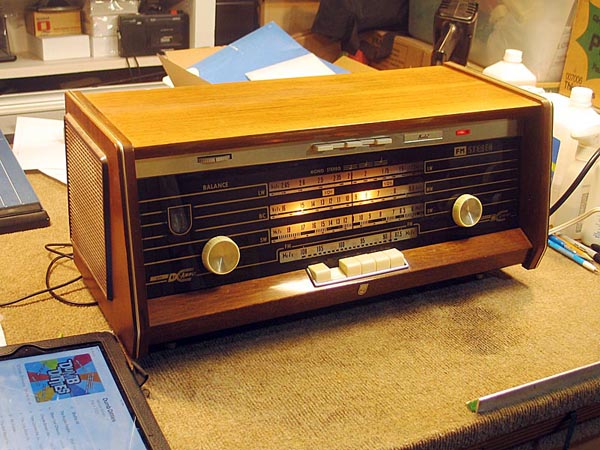
1963-1964 Philips B5X43A-74 and Norelco B5X43A-54 AM/FM/SW Stereo Radios
I bought the Philips B5X43A-74 radio in the PX in Germany in 1963 for $75.00, which would be equivalent to $612.00 in today's dollars. I found the Norelco version, shown at left, on eBay. Both radios were made in Holland, and the Norelco appears to be a rebadged Philips for the North American domestic market. The Norelco uses the same European type DIN tape and phono inputs on the rear as the Philips version does. The only external differences in the radios are the badges and the Norelco has a red stereo indicator light and the Phiips has a green stereo indicator light. These are export models, with the expanded American FM band and multiple voltage settings.
The AM and SW bands had died on the Philips, which I suspected was most likely a bad RF tube in the AM section. The Norelco was described by the seller as "working" but arrived with a very bad hum that could be felt as a strong vibration throughout the radio. My first impression was that it had a bad transformer.
I replaced the electrolytic capacitors in both radios and replaced the bad tubes in the Philips. The Norelco still had the same bad hum after recapping. The transformer was not the cause, so I started substituting tubes in the Norelco and replacing the 12AX7 pre-amp tube solved the problem. Both radios now play nicely, with the great audio quality found in these European table radios.
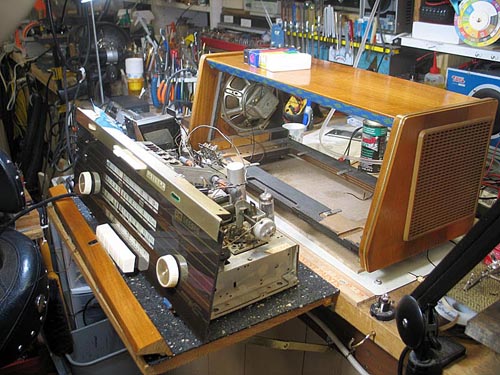 The Norelco radio was in very good cosmetic condition, and just required a good cleaning. The finish on the top of the Philips had deteroriated, and there was a small crack in the top of the side panel. I filled the crack with Platic Wood and stained it to match the rest of the finish. Then I recoated the top of the radio with polyurethane spar varnish, which is a close match to the finish on these radios.
The Norelco radio was in very good cosmetic condition, and just required a good cleaning. The finish on the top of the Philips had deteroriated, and there was a small crack in the top of the side panel. I filled the crack with Platic Wood and stained it to match the rest of the finish. Then I recoated the top of the radio with polyurethane spar varnish, which is a close match to the finish on these radios.
My daughters grew up with the Philips, so I gave the Philips to one and the Norelco to the other. The Philips is shown below, before I began restoration work on it.

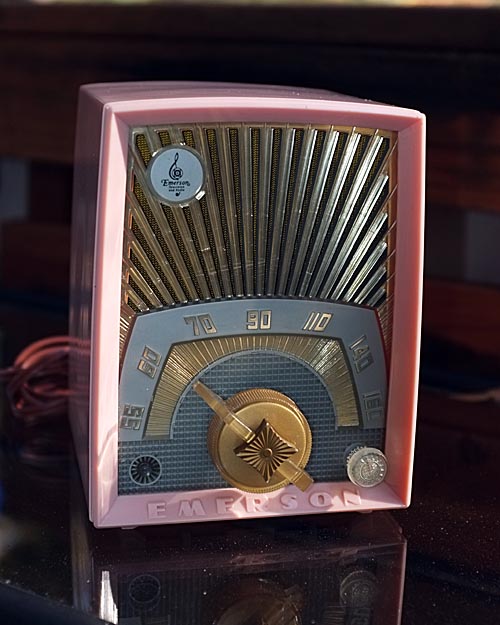
1952 Emerson Model 707B AM Table Radio
I found this radio on Goodwill's auction website, and thought it would make a nice gift for a young granddaughter. I was attracted by the Art Deco styling and, particularly, the sun-burst speaker grill. When I tested the radio, it produced a loud hum, no signal reception. Replacing the electrolytic multi-capicitor eliminated the hum, but still no RF reception. I then replaced the remaining caps in the radio and tested it again. I now picked up the signal from my Talking House transmitter, but nothing else.
At this point, I suspected a bad tube, and it turned out that the 12BE6 was barely alive, testing in the "BAD" range on the tube tester meter. Replacing the bad tube solved the problem and the radio played like a champ, with good volume and sensitivity. I then replaced several out of tolerance resistors and installed a new power cord.
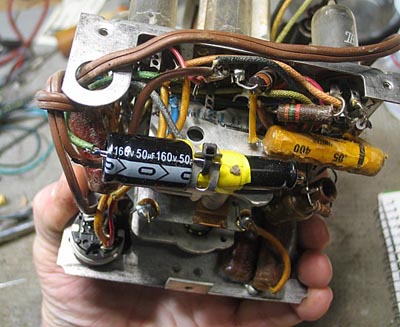 I gave the cabinet and knobs a good cleaning and polishing, and the project was finished.
I gave the cabinet and knobs a good cleaning and polishing, and the project was finished.
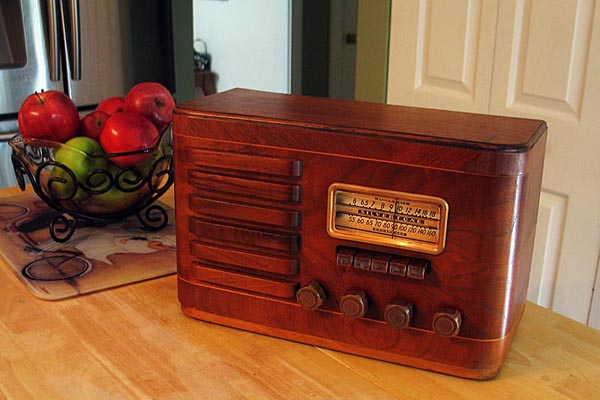
1939 Silvertone Model 6421 AM/SW Table Radio
This turned out to be one of the most challenging restorations yet. I could not get this radio to play after a recap, and spent hours tracing circuits, looking for bad joints, broken wires, etc. I ended up replacing the On/Off/Tone control and one tube socket, but still couldn't get reliable performance. It turned out to be a bad band switch. The wafer material had warped over the years, so the contacts never made good, solid contact. I tried repairing the switch, but still had unreliable performance. I ended up replacing that switch as well, not an easy task as it is a 3PD2 switch, and I couldn't find an exact replacement. I ended up using a 4PD2 switch I found on eBay.
I also had to replace the field coil speaker with a PM speaker, adding a 450 ohm, 5W resistor in place of the field coil, which I mounted on a terminal strip on top of the chassis for good ventilation. I was able to use the original audio transformer. In addition to the electrical restoration, I did some cosmetic work on the cabinet, which features nice veneer with bands of zebrawood veneer along the top and bottom. I removed the old finish from the cabinet, replaced some missing veneer at the top right, and applied new lacquer and toner. I also made a new dial cover as the old one was cracked and yellowed.
This is a two band radio, covering the AM broadcast band and SW from about 6 mHz to 18 mHz. It appears to be fairly sensitive on the AM broadcast band, picking up all the available stations in my area. I also was able to pick up a number of SW stations as well. It uses a built-in loop antenna, and has provisions for an external antenna as well. The tube line-up 6K8 oscillator-converter; 6U7 IF; 6J5 detector-avc; 6F5 audio, 25L6 output, and a 25Z6 rectifier.
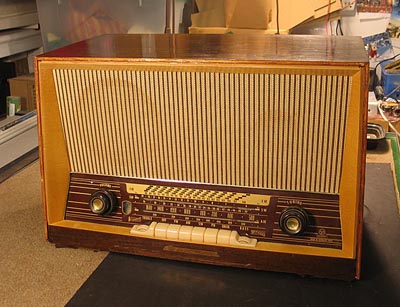
Ca 1958-1959 AJA Electronic German AM/FM/SW Table Radio
This is another freebie from a brother-in-law who got it at an auction when it was thrown in with a lot he was bidding on. The cabinet is missing the front trim and one side has several splits in the veneer, otherwise the cosmetic condition is not too bad. This radio has no model number, but is almost identical to a "AJA Electronic Unknown 3D Exportmodell" shown on radiomuseum.org. It appears to be a low cost model compared to the AJA model 5842, which is more common. AJA was in business in West Germany, according to information on the web, from the end of WWII to about 1960. Better known brands like Grundig forced it out of business.
The radio was missing the fuse, so it didn't play. I installed the proper fuse and the radio played extremely well, with no hum, static, or other issues. I only played it for a few seconds as I wasn't sure why the fuse was missing. I pulled the chassis and was quite impressed with the clean, uncluttered layout. I replaced the electrolytic caps, as shown in the photo, and this was probably the easiest electrolytic cap replacement I've ever done.
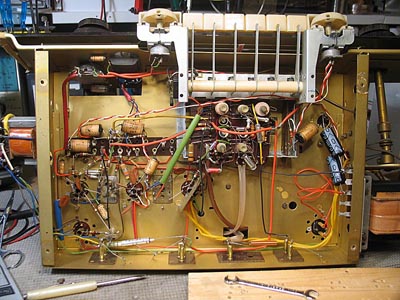 This is a six tube radio, using an ECC 85 for FM, ECH81 converter, EF89 IF, EABC80 detector, and EC84 audio. The sixth tube is the eye tube, but I didn't pull it to see which one. It also uses a selenium rectifier in place of a rectifier tube. After cleaning the chassis and servicing the tuning mechanism, I hooked it up to test again as shown above.
This is a six tube radio, using an ECC 85 for FM, ECH81 converter, EF89 IF, EABC80 detector, and EC84 audio. The sixth tube is the eye tube, but I didn't pull it to see which one. It also uses a selenium rectifier in place of a rectifier tube. After cleaning the chassis and servicing the tuning mechanism, I hooked it up to test again as shown above.
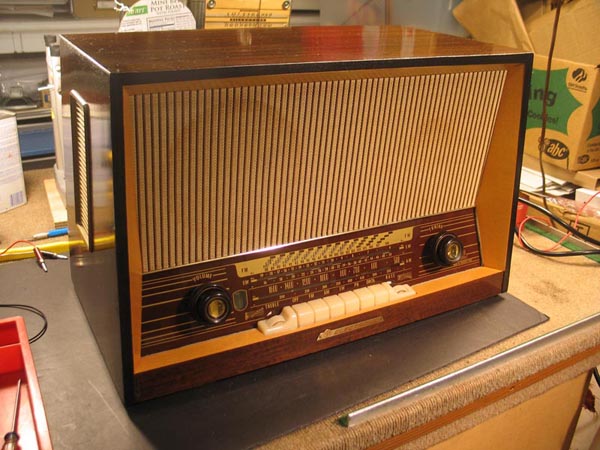 I also made an adapter to connect my iPod to the phono input and it works very well, with great sound. I also connected a phonograph with ceramic cartridge and again had excellect audio.
I also made an adapter to connect my iPod to the phono input and it works very well, with great sound. I also connected a phonograph with ceramic cartridge and again had excellect audio.
I replaced the missing trim on the front panel with veneer, and did a lot of other cosmetic touch-up to the cabinet, and finished up with a coat of wax.
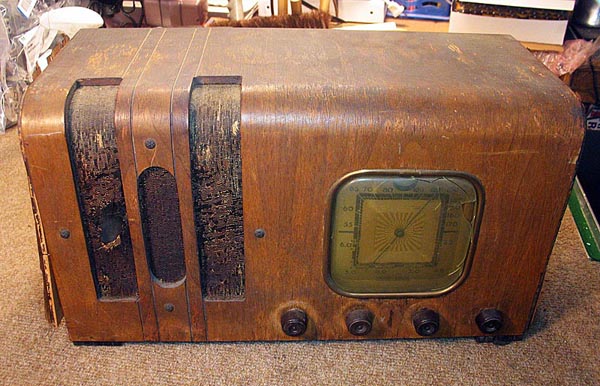
1938 Belknap Model 623 AM/SW Table Radio
I restored this rarely found Belknap radio for a friend. Belknap was a regional brand based in Louisville, KY. Their radios were sold in department store chains throughout the mid-west. This radio was in extremely poor condition and I first suggested to my friend that we trash the cabinet and sell the chassis. At the time, we could not find any identifying information on the radio. However, I posted some photos on the Antique Radio Forum, and several members recognized the Warwick built chassis, which was often used in Coronado branded radios, a better known mid-west regional brand sold through the Gamble-Skogmo department store chain. However, we could not match it to any known Coronado models.
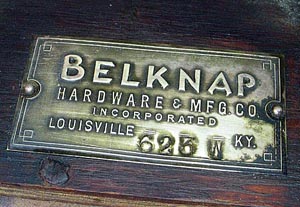
After removing the chassis, and cleaning almost 80 years of grunge, I found a brass label identifying the radio as a Belknap, with a 623W (Warwick) chassis. This radio seemed too unusual to part out, so I decided to see if I could restore it. Using the Gamble-Skogmo 623 schematic, I was able to recap the radio, but it still wouldn't play. The problem turned out to be an open audio transformer. I found a suitable replacement on eBay, and the radio returned to life.

Next came restoration of the cabinet. Both ends of the cabinet were delaminated, split, and shedding veneer, but the rest of the cabinet was actually in pretty good shape. However, there was no choice but the replace the ends. The rest of the cabinet was in pretty good shape, except for the tattered speaker cloth and the cracked and yellowed dial cover. I fabricated new side panels and glued them into place. I had to wait several months for the weather to improve so I could take the cabinet outside to lacquer and tone it. I was not quite able to get a perfect match on the end panels. I then installed a new speaker cloth and made a new plastic dial cover.
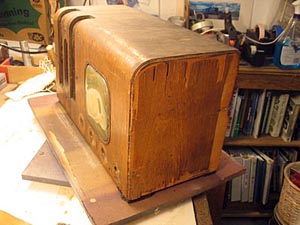
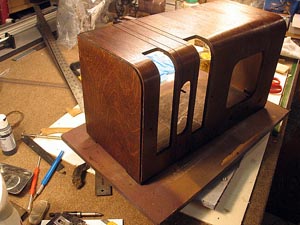
The radio has good sound, but it was only picking up one or two AM broadcast stations, although it did much better on SW. I traced the problem to a very dirty band switch I forgot to clean when I had the chassis out the first time. Once cleaned, the sensistivity of the radio improved considerably. This radio is a very fine example of art deco style, and it a relatively uncommon radio.
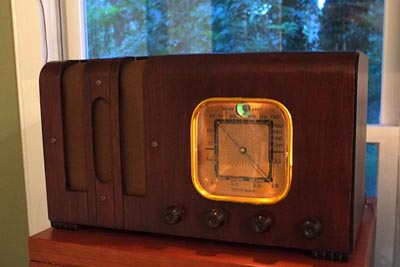
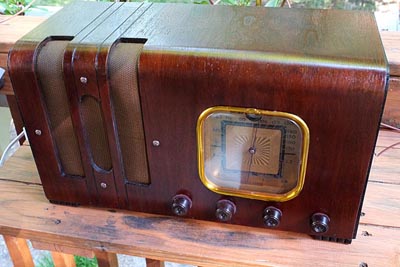
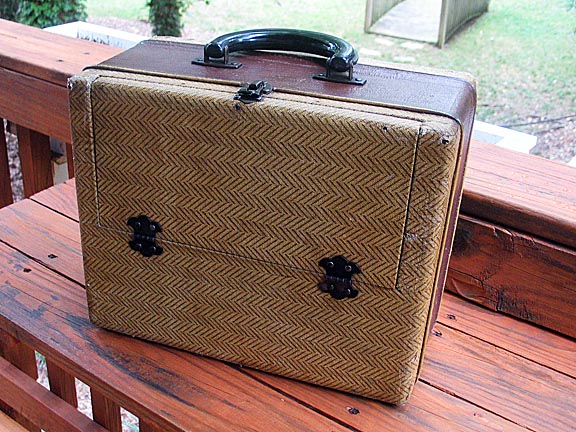
Mantola was a house brand for radios sold by BF Goodrich in their dealer stores in the mid 20th century. This portable radio may have been made by U.S. Radio & Television, although Mantolas are thought to have been made by several manufacturers.
 This model is a well built radio and includes an RF amplifier section, with a three-gang tuning section, so it is a good performer with decent sound. The third section of the tuning gang is actually a slug-tuned capacitor, similar to those used on car radios, to provide additonal stability.
This model is a well built radio and includes an RF amplifier section, with a three-gang tuning section, so it is a good performer with decent sound. The third section of the tuning gang is actually a slug-tuned capacitor, similar to those used on car radios, to provide additonal stability.
The cabinet is in fair condition, and there is some deformation in the dial bezel and a small crack.
The knobs were missing, and the only knobs I had that would work were knobs from a Zenith portable of the same era. I cleaned the cabinet with soap and water. After it had dried for several days, I gave it a coat of lacquer.
Electronic restoration consisted of the usual recapping and replacement of out of tolerance resistors. After recapping, I was getting a lot of distortation, which was caused by incorrect AVC voltage. The IH5 det-avc-AF tube turned out to be weak, and a NOS tube solved the problem.
The battery changeover switch is a little flakey, and sometimes requires a little fiddlling to get the radio to play on AC. The radio can also be powered by a 9v/90v AB battery, such as the Eveready 754.
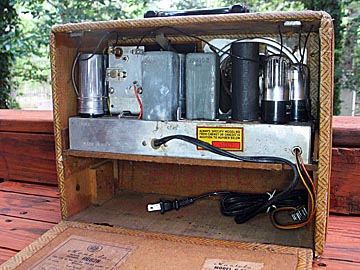

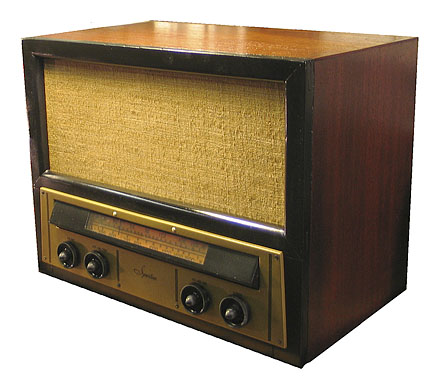
This radio turned out to be a thirteen month project. The radio was found under a bed in a spare bedroom of my wife's late parents' home in Franklin County, VA. It was in poor condition, with a missing dial pointer and a couple other small parts. The dial scale had shrunk, which appears to be common on this model. Also the on/off switch on the tone control was broken, and years ago someone had rigged a switch which they installed in the middle of the front bezel, leaving a nice hole in the center.
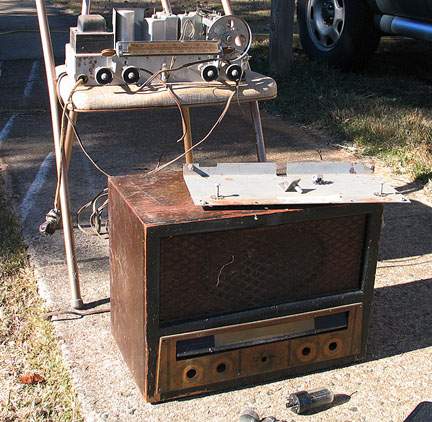 After recapping and replacing tubes that tested bad, I had a pretty good sounding radio on AM and Phono, but FM reception was extremely weak, with only one or two stations barely audible. Then the radio started motorboating, and I put it aside for awhile. With some help from the Antique Radio Forum, I found that the motorboating was caused by a gassy 6BA6 FM IF tube. Replacing the 6BA6 not only fixed the motorboating, but improved the FM performance significantly. An alignment helped a little bit more, but the FM is still marginal in my opinion.
After recapping and replacing tubes that tested bad, I had a pretty good sounding radio on AM and Phono, but FM reception was extremely weak, with only one or two stations barely audible. Then the radio started motorboating, and I put it aside for awhile. With some help from the Antique Radio Forum, I found that the motorboating was caused by a gassy 6BA6 FM IF tube. Replacing the 6BA6 not only fixed the motorboating, but improved the FM performance significantly. An alignment helped a little bit more, but the FM is still marginal in my opinion.
Aside from recapping and replacing bad tubes, restoration consisted of cleaning rust from the chassis and repainting it, fabricating a new dial scale and pointer, and restoration of the cabinet. Cabinet restoration consisted of making new decals for the front bezel in Photoshop, then stripping the finish from the brass bezel, filling the hole in the center, and repainting and installing the new decals I made. I also stripped the old lacquer from the cabinet and applied a light coat of matching stain over the original finish to cover scratches, then applied about twelve coats of lacquer and toner. The front was painted black as on the original. It probably would have benefitted from some grain filler, but I only had a few days of good weather to do the stripping and new lacquer, so I decided to skip the grain filler. I also installed a new grill cloth. Because the dial scale, pointer, and grill cloth are not original, the radio does not look prototypical, but it is a nice looking radio, in spite of its uninspired cabinet design, and will go back to the old farmhouse where it will be right at home.
Back when I had doubts about getting this radio working again, I picked up another model 121 for parts. As it turned out, I only ended up using the rear chassis mounts. So I recapped the parts radio, refinished the cabinet and front dial bezel, and now I have two of them. The speaker grill was in good shape on the parts radio, so I didn't have to replace that.
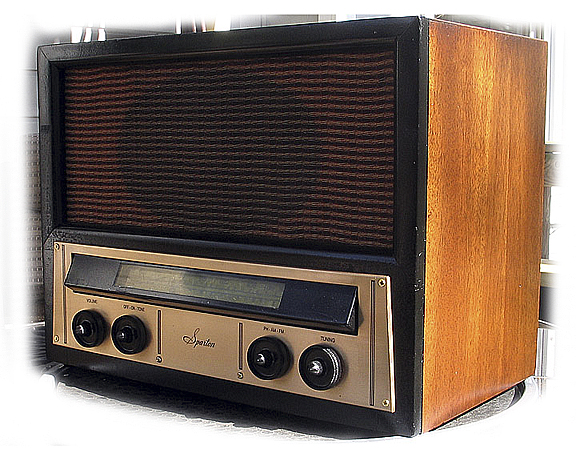
These are very nice sounding radios. The audio is a single-ended ouput through a 6V6GT tube into 6" by 8" oval speaker. I doubt the cabinet design will win any awards, though.
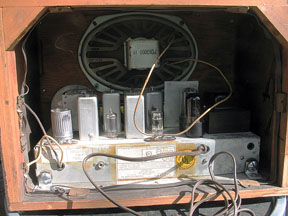
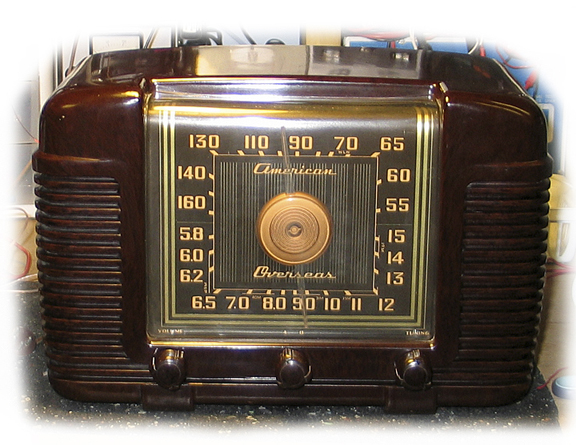
This is a battery powered farm radio made for rural areas that might not have had electricity in the first half of the last century. The radio uses 1.5 volts for the filaments and 90 volts for the plate voltage. To power the radio, I built the reproduction battery shown in the photo, below right. As can be seen, the cabinet on this radio is in excellent condition, except for the missing back cover. Electronically, restoration consisted of recapping, replacing two bad tubes, repairing the broken battery plug, and repairing an open antenna coil. I think that it's a very handsome radio, and with a 50-foot long wire antenna attached, performance is pretty decent. The radio has a very solid feel to the controls, much like the knobs and switches on the older Volvos.

Click here to see and hear the Crosley radio play!
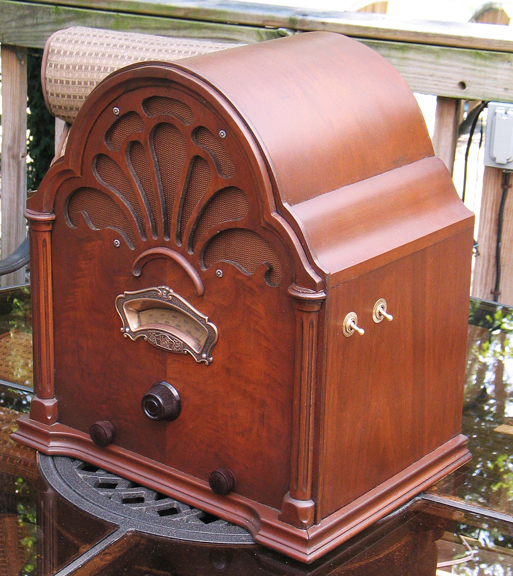
It's alive!...It's alive...! This is a 1931 U.S. Radio & Television Apex 8A cabinet with a 1953 GE Model 546 clock radio chassis inside, hence "Frankenradio." In the winter of 2009, I was given an Apex cabinet with all the hardware except the chassis. The cabinet had some damage on the top where it had been apparently dropped. Anyway, I've had no luck finding a chassis. In the meantime, I finally repaired the damage, so I stuck in a chassis from a GE clock radio I found at a yard sale for 50 cents. The volume and tuning shafts of the GE match perfectly the two lower holes in the Apex cabinet.
The left lower knob is the volume control and the right is tuning. The large center knob is just mounted on a bolt and serves no purpose at present, nor does the original 80 year-old hi power/lo power switch on the side. The original on/off toggle switch on the side turns the radio on or off. The GE also had a phono input, so I can play a CD or iPod through the radio as well. I installed a new reproduction grill cloth which is a very close match to the original, and an old speaker from Radio Shack. I have the original 8" Utah speaker that was in the cabinet to reinstall whenever (or if ever) I find an Apex chassis.
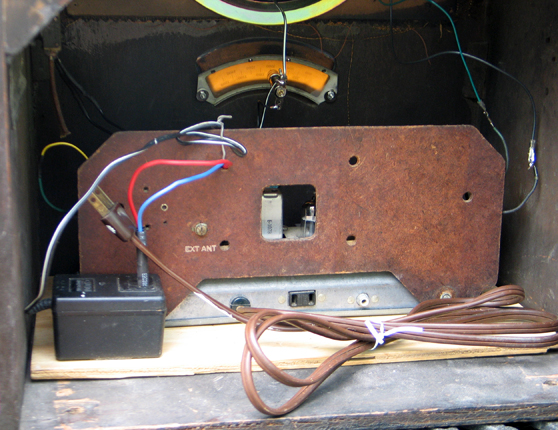 I made no modifications to the cabinet, so if I ever find a chassis, all I have to do is pull out the GE chassis and replace it with the Apex chassis. I found an old unused wall wart in the junk box so I used it to power a dial light that comes on with the on/off switch. The ac adapter is hot glued to the plywood base.
I made no modifications to the cabinet, so if I ever find a chassis, all I have to do is pull out the GE chassis and replace it with the Apex chassis. I found an old unused wall wart in the junk box so I used it to power a dial light that comes on with the on/off switch. The ac adapter is hot glued to the plywood base.
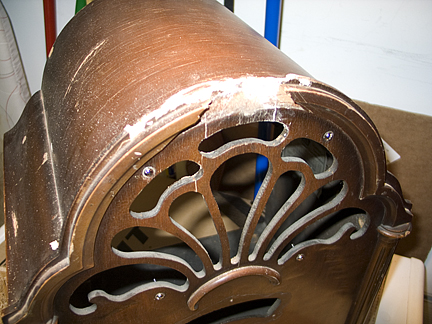 After repairing the damage, I used Minwax antique furniture restorer to remove the old lacquer. I applied walnut stain over the repaired and sanded areas, then applied spray lacquer and toner to even out the colors. In all, I applied about a dozen coats of lacquer. I'm not too skilled at woodworking, so the repair doesn't look all that good up close.
After repairing the damage, I used Minwax antique furniture restorer to remove the old lacquer. I applied walnut stain over the repaired and sanded areas, then applied spray lacquer and toner to even out the colors. In all, I applied about a dozen coats of lacquer. I'm not too skilled at woodworking, so the repair doesn't look all that good up close.
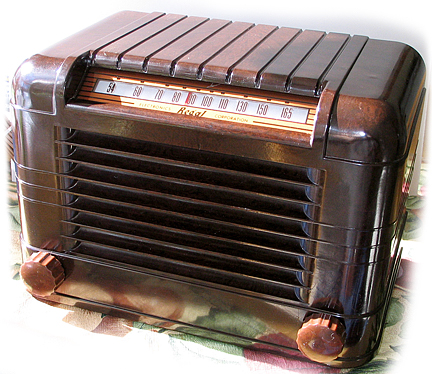 Regal AA5, Unknown Model
Regal AA5, Unknown Modelc1946 Regal AA5 AM receiver. I haven't been able to identify the specific model. It uses the same cabinet as the Regal 205, but electronically is similar to the model 7251. This is a post-WWII radio made when parts were still in short supply. It uses a 12SA7 tube for the converter/mixer, a 12SQ7 for the detector/AF/AVC, and a 50L6 for the output, and a 35Z5 rectifier tube; but it uses a mini 7 pin 12BA6 for the IF stage instead of a 12SK7. It has only one IF transformer to handle both IF input and output. Unfortunately, the IF transformer exhibits early symptoms of silver mica migration, which causes occasional static during reception. The dial string and dial pointer were missing from the radio. After stringing a new dial cord, I made a new dial slide and pointer from styrene plastic. The radio plays with decent sound and sensitivity. The radio was also missing its knobs, and the replacements I used are a lighter shade of Bakelite than the cabinet.
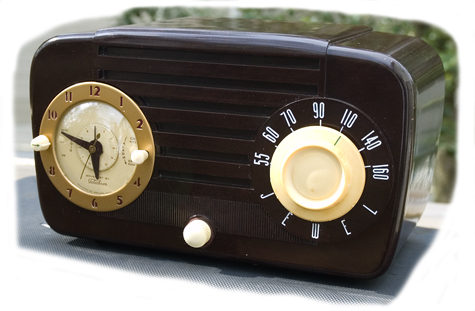 Jewel Model 910
Jewel Model 910This is a very early version of the Model 910. It is a four octal tube AC/DC radio with no AVC and a very primitive volume control in the RF stage. As can be imagined, the radio is not very sensitive, and tuning from staion to station requires constant adjustment to the volume. If you tune a strong station with the volume too high, you may get a piercing harmonic howl. I only bought the radio as a parts radio for a Model 935 I was restoring, not realizing it had a completely different chassis. Jewel used this same cabinet for the 910, 920, 920A, 935, and 936. The radio became a 5 tube AC/DC superhet by the model 920. The schematic for the 910 shows miniature tubes, not the octals as this one has, so it must be one of the very first models off the line after the war when parts were still hard to get for consumer production. The chassis had considerable rust and the volume pot was completely worn out. Because the volume control is in the RF stage, it requires a reverse audio pot which was hard to find. After recapping and replacing some resistors and the pot, it plays as well as can be expected given the design, but the cabinet and clock were in very good shape and the cleaned up radio is very nice looking.
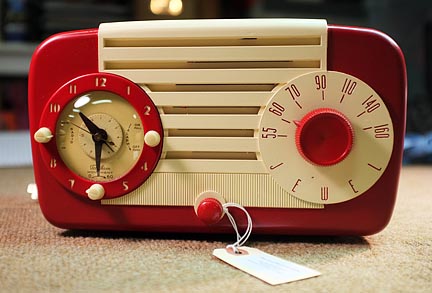 Jewel Model 921
Jewel Model 921
I rarely customize a radio cabinet, but the Bakelite cabinet on this Jewel 921, an AA5 version of the 910 above with modern miniature tubes, was in poor condition, and I was thinking of giving this radio to one of the kids, so I tried a little "hot-rodding" on the chassis. The radio was recapped and is a much better performer than the 910.
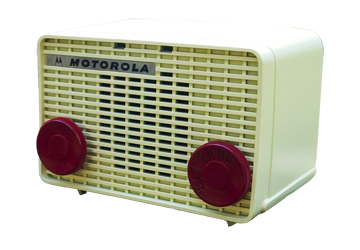 This tiny tube radio was a rescue. It had been sitting outdoors for some time and the cabinet was quite weathered. This is a late 1950's model radio with a PC board rather than a metal chassis. With a couple new tubes, it actually played very well with no other repairs. However, I went ahead and replaced all the capacitors and all but two resistors. The hardest part was finding a replacement speaker. The originial speaker cone was rotted from being outdoors. I finally found a replacement that would work from Mouser Electronics. The original radio was a dark brown plastic, but badly deteriorated. I cleaned it up, then applied two coats of Krylon primer, followed by several coats of Krylon buttercream yellow. I wet-sanded with 600 grit sandpaper between each coat of primer and finish color. This was my first attempt at repainting a badly deteriorated cabinet. The Jewel 921 in the preceding section was my second effort.
This tiny tube radio was a rescue. It had been sitting outdoors for some time and the cabinet was quite weathered. This is a late 1950's model radio with a PC board rather than a metal chassis. With a couple new tubes, it actually played very well with no other repairs. However, I went ahead and replaced all the capacitors and all but two resistors. The hardest part was finding a replacement speaker. The originial speaker cone was rotted from being outdoors. I finally found a replacement that would work from Mouser Electronics. The original radio was a dark brown plastic, but badly deteriorated. I cleaned it up, then applied two coats of Krylon primer, followed by several coats of Krylon buttercream yellow. I wet-sanded with 600 grit sandpaper between each coat of primer and finish color. This was my first attempt at repainting a badly deteriorated cabinet. The Jewel 921 in the preceding section was my second effort.
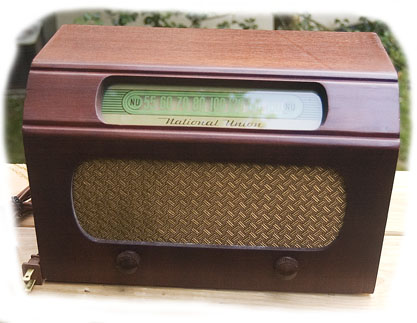
I bought this radio on E-Bay. The cabinet needed a full restoration, and was my first attempt at a wood cabinet restoration. The veneer on the right side was peeled back and there were several areas with missing veneer.
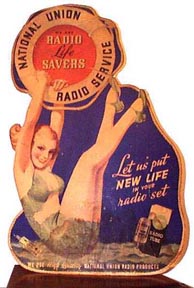 The first step was to glue the cabinet back together. I then stripped the old finish off with Minwax Antique Furniture Refinisher. Following that step, I replaced all missing veneer with new. I then lightly sanded the cabinet and then applied a light coat of stain. This was followed with multiple coats of spray lacquer, toners, and more lacquer, for more than a dozen coats. I lightly wet sanded every three our four coats. I intalled a new grill cloth, but learned a painful lesson--a stray thread wound around the tuning knob shaft and unraveled a portion of the grill cloth. I had to replace it, and the second time didn't come out quite as nice as the first.
The first step was to glue the cabinet back together. I then stripped the old finish off with Minwax Antique Furniture Refinisher. Following that step, I replaced all missing veneer with new. I then lightly sanded the cabinet and then applied a light coat of stain. This was followed with multiple coats of spray lacquer, toners, and more lacquer, for more than a dozen coats. I lightly wet sanded every three our four coats. I intalled a new grill cloth, but learned a painful lesson--a stray thread wound around the tuning knob shaft and unraveled a portion of the grill cloth. I had to replace it, and the second time didn't come out quite as nice as the first.
I replaced all the electrolytic and paper capacitors and some out of tolerance resistors. The tuning capacitor had some bent plates and it took some work to align them for good reception, along with considerable cleaning and some lubrication. Now the radio plays very well, with strong volume and good sensitivity.
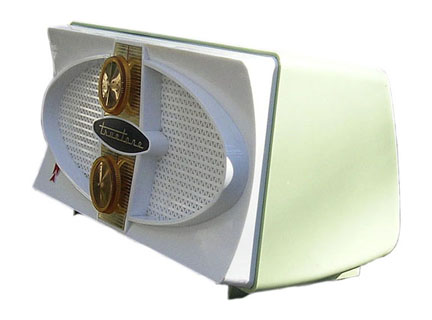
Many radios were marketed under house brand names such as Western Auto, Sears, Montgomery Wards, Firestone, etc. Some of these radios are harder to find than the big brands such as RCA, GE, Westinghouse, Crosley, etc. This model is a basic 5 tube design, AM only, but internally begins to show signs of the modern era. The steel chassis is gone; instead the tube sockets, caps, and resistors are mounted on an early style of circuit board.